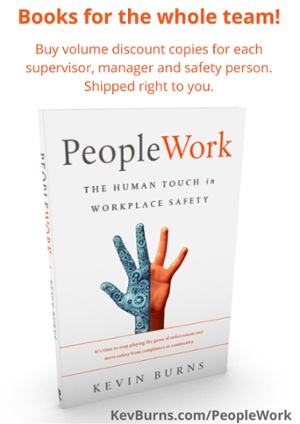By implementing an internal marketing strategy for safety, employees are treated as critical stakeholders who must be convinced of a company's safety vision.
To get employees to buy-in to safety, you need a consistent and compelling message that resonates with your people. And, to be clear, a compelling message is not some safety slogan you downloaded from the Internet. Don’t just take something you think is clever that someone else came up with and turn it into posters all over your workplace. You’ve got to understand what resonates with your team.
Ever wonder why safety first and send people home safe messages don’t get people fired up to follow safety? It’s because they're meaningless. Safety first is used sometimes as a joke people say just before some guy does something stupid. (“Hey, safety first right?”)
Sending people home safe isn’t a phrase anyone can warm up to because sending people home safe is what we’re supposed to do by law. We are not allowed to do less than send people home safe. And going home safe is the expectation of every employee showing up in the morning. They expect that their employer has done everything to ensure the work is safe.
Generic safety slogans don’t get your people to work better together or to pay more attention to safety. They’re just meaningless words.
Here’s why safety marketing matters.
Educating your employees about the company's safety goals and motivating them to be enthusiastic about meeting those goals are two separate things. Your meetings may inform them, but they do little to create buy-in or teamwork. You need to consider the power of marketing your safety message.
What is safety marketing? Whenever any organization is trying to roll out a new internal employee initiative, they create a strategy to introduce it to convince their people to get on board. They plan a communications strategy, tie in promotions, awareness campaigns, visual messages and supplement with references to the strategies’ outcomes in the words they use. They empower supervisors to advocate for the program and equip them with skills to do it.
That’s all tied to marketing to employees internally.
And by implementing an internal marketing strategy for safety, employees are treated as critical stakeholders who must be convinced of a company's safety vision.
Show your people safety’s benefit, and they will buy-in.
 When you’re trying to convince someone of an idea or a point of view, you’re marketing. You’re not forcing them to do something against their will. You’re not being dishonest. You’re trying to get them to see how safety benefits them.
When you’re trying to convince someone of an idea or a point of view, you’re marketing. You’re not forcing them to do something against their will. You’re not being dishonest. You’re trying to get them to see how safety benefits them.
You need a message that resonates, at the right time, to the right people so that every employee is working toward common goals in safety. To be compelling and to resonate, your message has to be created specifically for your people.
Spend some time thinking about how to create a movement of safety-minded employees who are more than willing to look out for each other. Build a marketing strategy that reaches your people – and makes them want to be part of safety. (And if you want help doing it, I can help you with that. It is one of the things I do.)
But first, if you want to get more information on how to create a marketing plan for safety, there are two full chapters on safety marketing in my book PeopleWork: The Human Touch in Workplace Safety.
--
Learn more strategies to create a high-participation safety culture. Put Kevin Burns' expertise to work in your organization. Kevin Burns is the creator of the M4 Method™ and the 90-Day Safety Accelerator program. He is the author of PeopleWork: The Human Touch in Workplace Safety.
Get details and more information http://www.kevburns.com/contact


